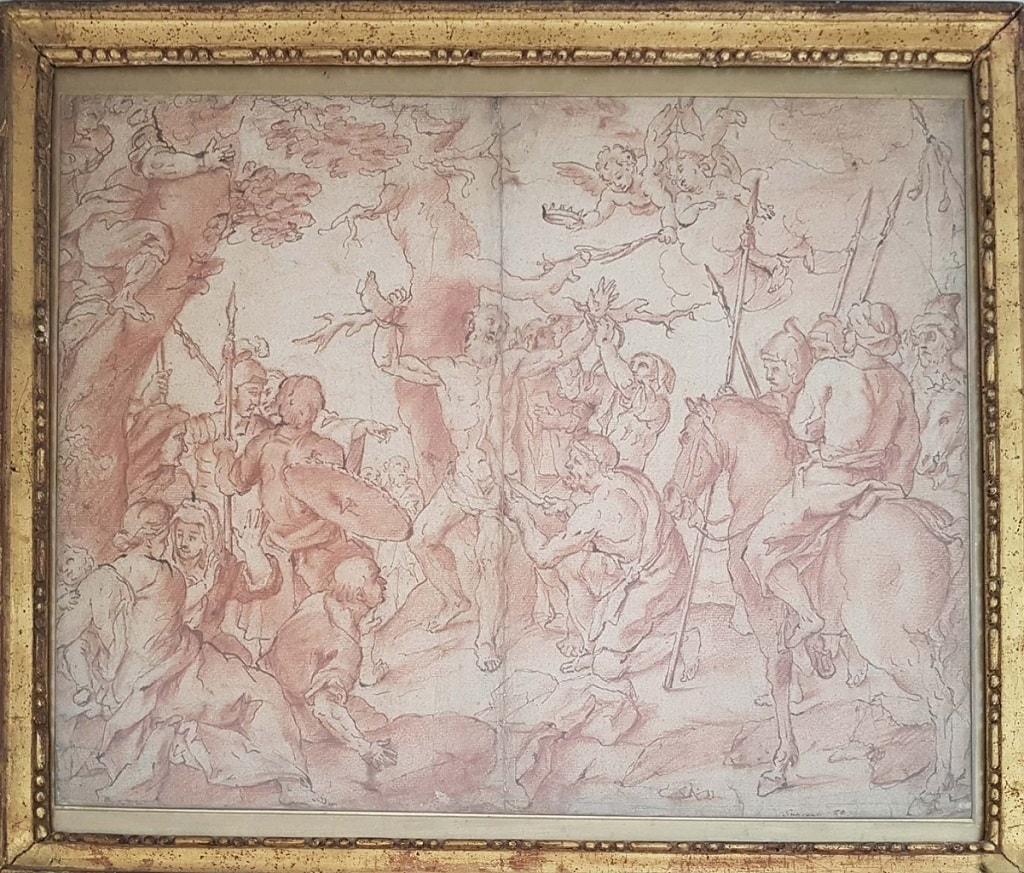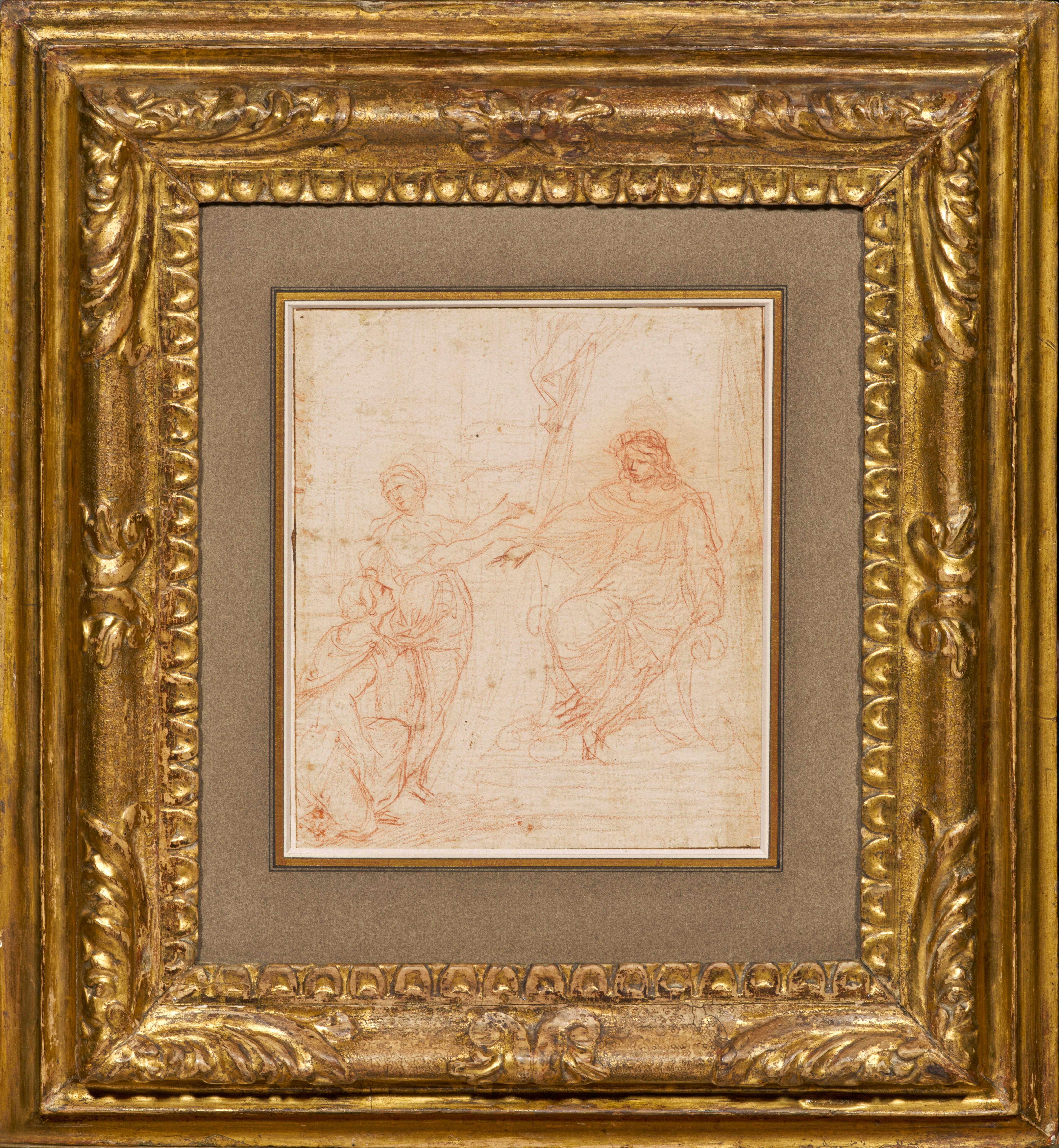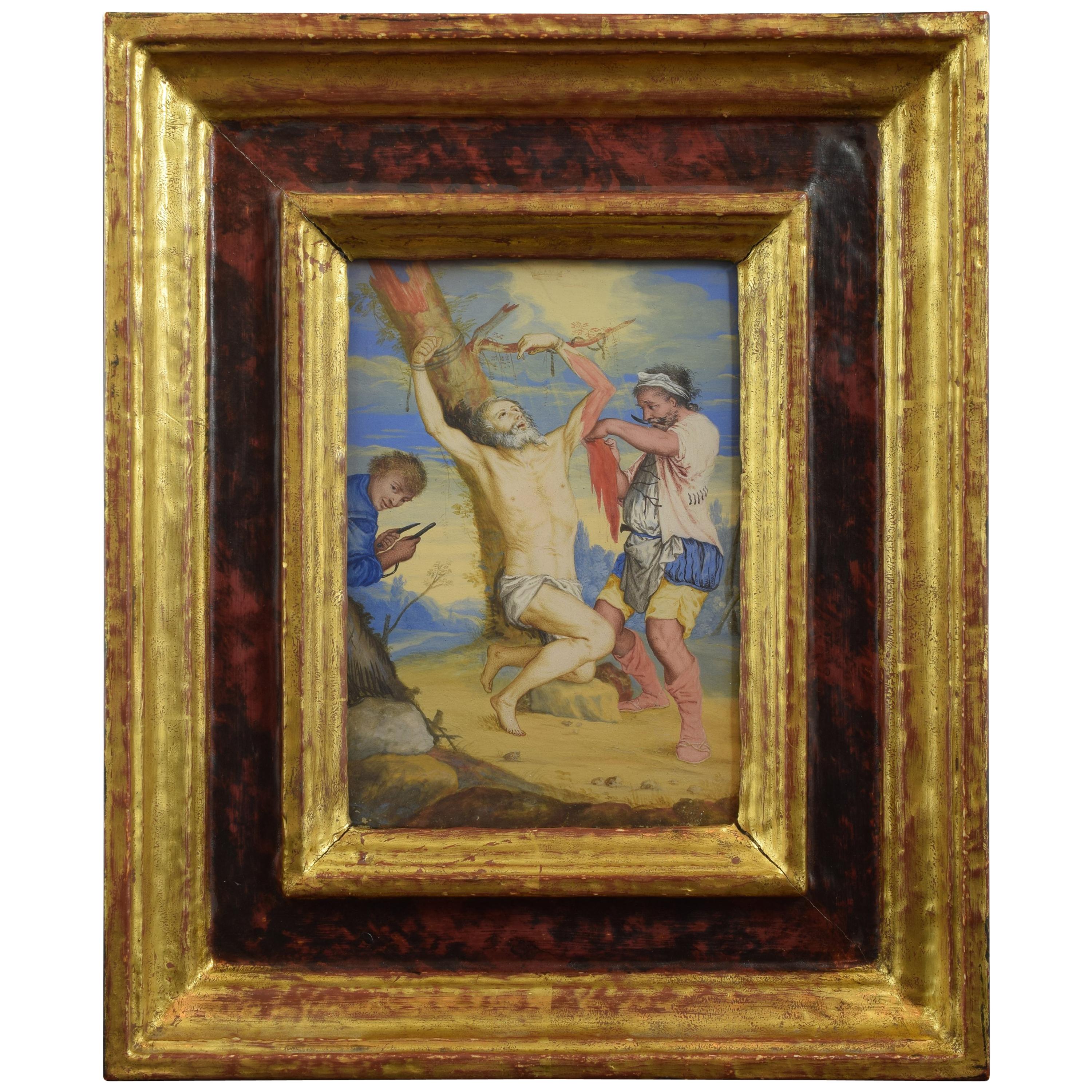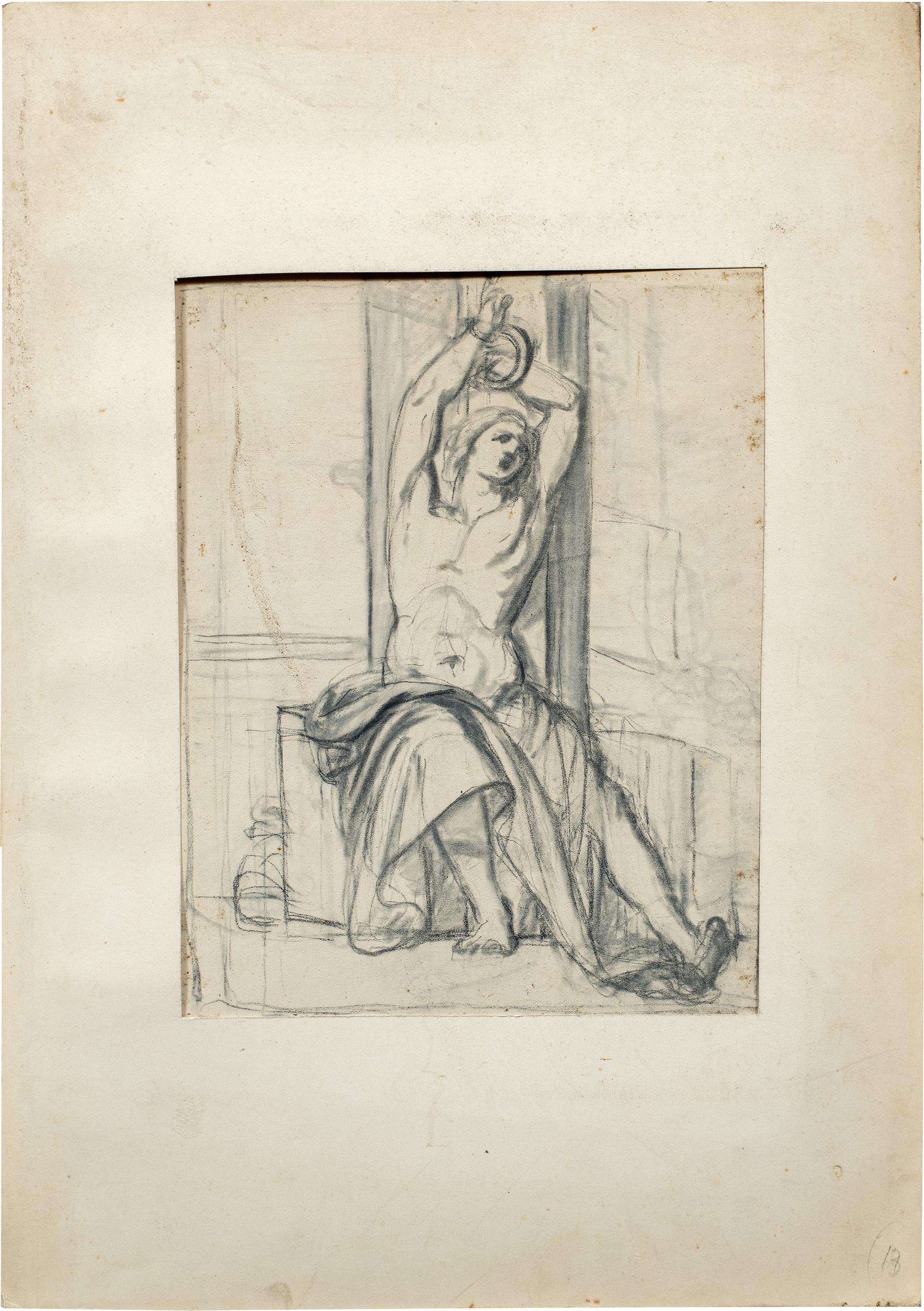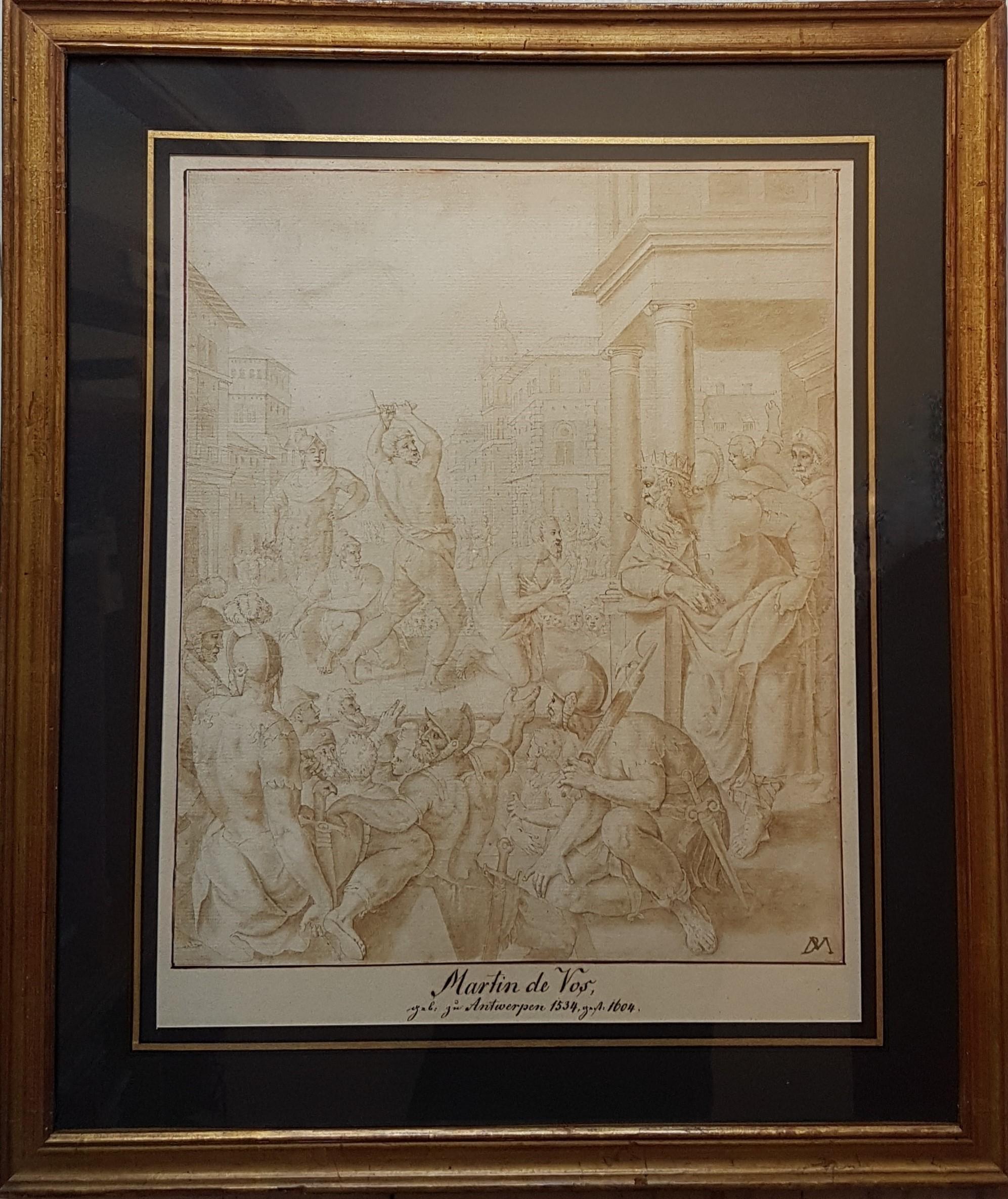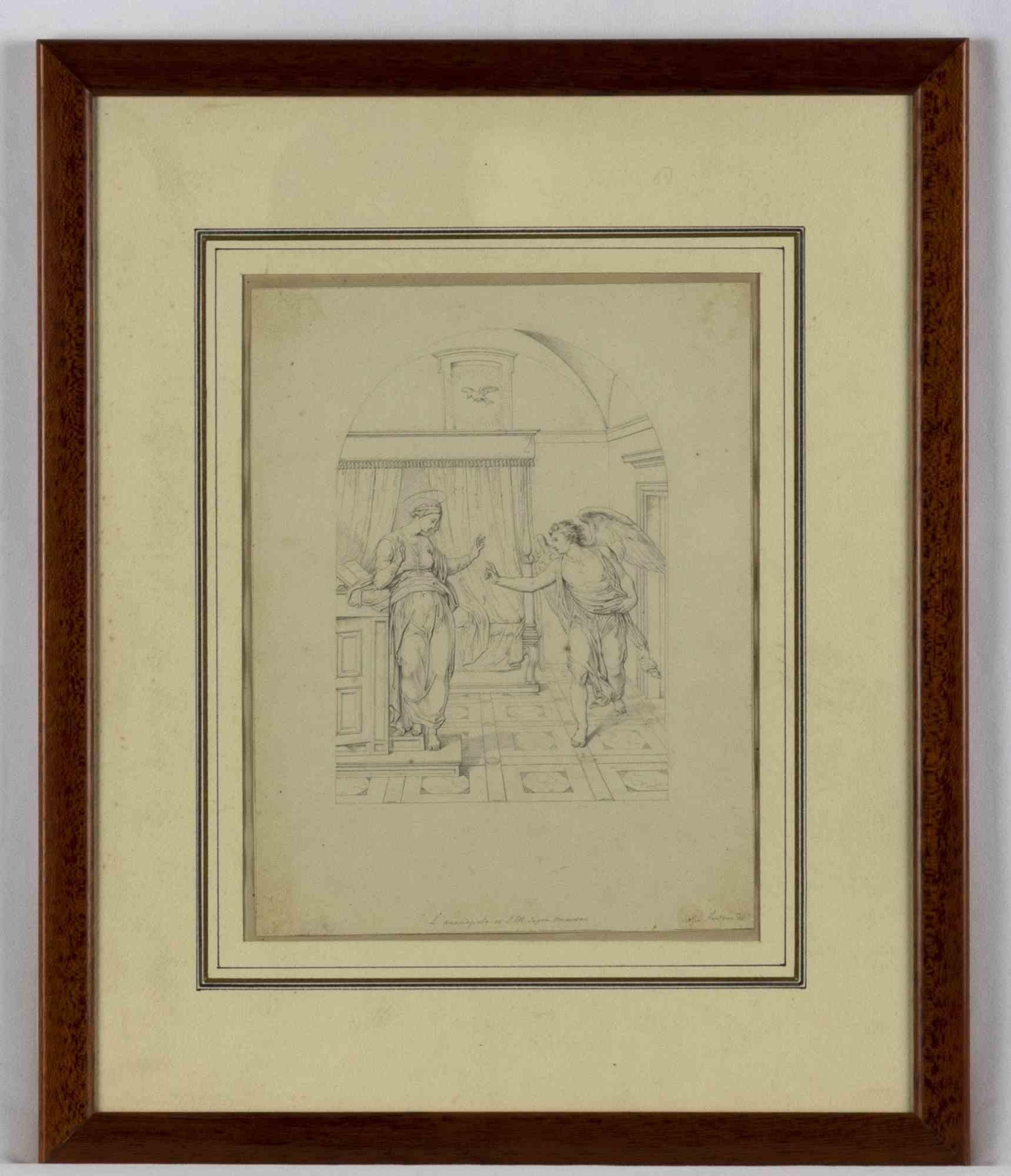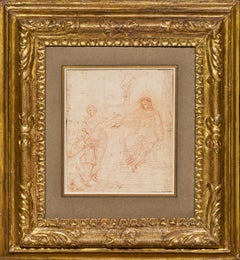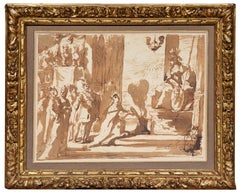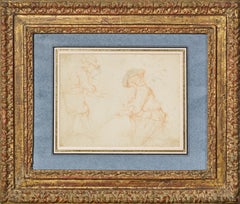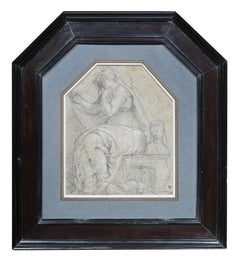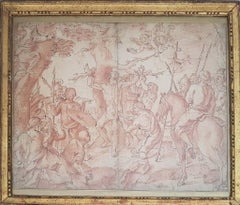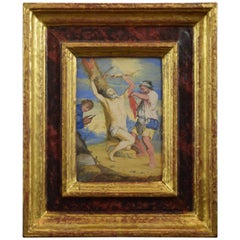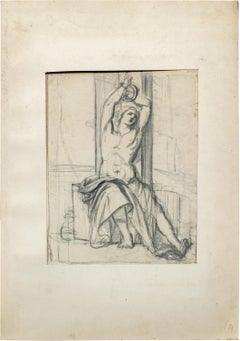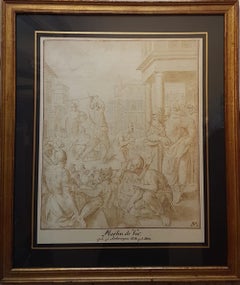Items Similar to The Martyrdom of Saint Bartholomew, a preparatory drawing by Alessandro Casolani
Want more images or videos?
Request additional images or videos from the seller
1 of 9
Alessandro CasolaniThe Martyrdom of Saint Bartholomew, a preparatory drawing by Alessandro Casolani
$18,452.47
£13,715.20
€15,500
CA$25,477.78
A$28,252.98
CHF 14,844.84
MX$345,203.37
NOK 185,729.25
SEK 174,338.63
DKK 118,024.75
About the Item
This powerful pen and brown ink wash drawing is a study for an altarpiece depicting The Martyrdom of Saint Bartholomew. Signed and dated 1604, it was painted at the end of his life by Alessandro Casolani, one of the last representatives of Sienese Mannerism, for the nave of the church of San Niccolo al Carmine in Siena, where it is still preserved.
Although very close to the final composition, our drawing features several morbid details that will be considerably toned down in the final painted composition. It was part of the drawings from Portuguese collections which were exhibited in several prestigious European museums (including the Prado in Madrid) in 2000-2002.
1. Alessandro Casolani, a late Sienese mannerist influenced by Federico Barocci
Born in Mensano, a hamlet in the municipality of Casole d'Elsa, near Siena, Alessandro Casolani received his first artistic training in Siena, probably with Arcangelo Salimbeni (ca. 1536 - 1579), a disciple of Domenico Beccafumi (c. 1486 - 1531) and Ventura's father. In 1578, Casolani visited Rome, where he familiarized himself with the painting of Federico Barocci.
Returning to Siena in 1581, Casolani quickly became one of the city's most fashionable painters, receiving commissions from the powerful societies of S. Caterina and SS Trinità, as well as from the public magistracy. Outside Siena, he painted frescoes for the Carthusian monastery and the church of San Tommaso in Pavia.
2. A composition with morbid details that will be greatly toned down in its final version
Saint Bartholomew was one of Christ's apostles. According to the Golden Legend, he undertook a missionary journey to India and then Armenia, where he met an atrocious death by being flayed alive and crucified for refusing to worship idols.
In this drawing, the details of St. Bartholomew's martyrdom, surrounded by his three executioners, are depicted with a rather morbid, if not humorless, precision! The saint's wrists are attached to a horizontal wooden plank suspended above his head and linked to the column behind him. The plank is hoisted up by the rope held by the executioner shown standing on the right of the composition, while his colleague on the left begins to butcher the saint's right arm with both hands, holding his knife between his teeth. A third executioner, crouching on the right, is about to cut off the saint's left leg skin, while a small dog on the left is lapping up the blood on the floor...
While faithful to the overall composition, the altarpiece in the church of San Niccolo al Carmine (fourth picture in the gallery) presents a much toned-down version: the two knife-wielding executioners are shown cutting into the saint's arm and leg respectively, but the detail of the dog feasting on the martyr's blood has been replaced by a group of women seated on the steps of the execution site.
The painting, completed in 1604, was praised by Cardinal Federigo Borromeo during his visit to the Carmine on March 27, 1605.
The style of this drawing, characterized by light pen strokes reinforced by touches of dark wash, reveals the strong influence of Federico Barocci (c. 1535 - 1612) and has much in common with the "Barocceschi Senesi", the Sienese disciples of the famous Urbino-born painter: Francesco Vanni (1563-1610) (of whom we also present a drawing for sale) and Ventura Salimbeni (1568 - 1613), two artists from a slightly younger generation than Casolani, who like him have adopted many elements of Barocci's fluid pictorial style and devout imagery.
In his catalog published in 2000, Nicolas Turner compared the style and composition of this drawing with a drawing by Ventura Salimbeni depicting The Death of St. Clare with Pope Innocent IV Blessing her (last picture in the gallery), preparatory to a fresco painted in 1599 in the church of Santa Maria degli Angeli in Assisi.
3. Framing
Our drawing is presented in a sober 17th-century Italian fruitwood frame, adorned with an elegant corbin beak molding.
Provenance: Private collection, Lisbon - Portugal
Sotheby's London, July 2, 1997, Lot 123
Exhibitions : Fitzwilliam Museum, Cambridge (United Kingdom) - European Master Drawings from Portuguese Collections (1500 - 1800), (16 May to 13 August 2000) Cat. Nr. 28
Centro cultural de Belém, Lisbon (Portugal) Desenhos de mestres europeus em colecções portuguesas (October-December 2000), Cat. Nr. 28
Museu Nacional Soares Dos Reis, Porto (Portugal) Desenhos de mestres europeus em colecções portuguesas, (October-December 2001), Cat. Nr. 28
Museu Nacional del Prado, Madrid (Spain) Dibujos de maestros europeus en las colecciones portuguesas (1500-1800), 2002, Cat. Nr. 18
Literature: This drawing is reproduced in Nicholas Turner's catalog (European Master Drawings from Portuguese collections) for the exhibition at the Centro Cultural de Belem in 2000 (pages 72 & 73).
- Creator:Alessandro Casolani (1552 - 1606, Italian)
- Dimensions:Height: 14.38 in (36.53 cm)Width: 12.75 in (32.39 cm)
- Medium:
- Movement & Style:
- Period:1600-1609
- Condition:6 7/8” x 5” (17.4 x 12.7 cm) (Framed: 14 3/8” x 12 ¾” - 36.6 x 32.2 cm).
- Gallery Location:PARIS, FR
- Reference Number:1stDibs: LU1568214116952
About the Seller
5.0
Vetted Professional Seller
Every seller passes strict standards for authenticity and reliability
Established in 2020
1stDibs seller since 2021
10 sales on 1stDibs
Typical response time: 3 hours
- ShippingRetrieving quote...Shipping from: PARIS, France
- Return Policy
Authenticity Guarantee
In the unlikely event there’s an issue with an item’s authenticity, contact us within 1 year for a full refund. DetailsMoney-Back Guarantee
If your item is not as described, is damaged in transit, or does not arrive, contact us within 7 days for a full refund. Details24-Hour Cancellation
You have a 24-hour grace period in which to reconsider your purchase, with no questions asked.Vetted Professional Sellers
Our world-class sellers must adhere to strict standards for service and quality, maintaining the integrity of our listings.Price-Match Guarantee
If you find that a seller listed the same item for a lower price elsewhere, we’ll match it.Trusted Global Delivery
Our best-in-class carrier network provides specialized shipping options worldwide, including custom delivery.More From This Seller
View AllStudies for the Judgment of Solomon, a double-sided drawing by Simone Cantarini
Located in PARIS, FR
In this double-sided red chalk study, Simone Cantarini offers us a double reflection on the theme of the Judgment of Solomon. This sheet reveals his precise style and his sense of de...
Category
1640s Old Masters Figurative Drawings and Watercolors
Materials
Chalk, Laid Paper
Allegory of the Treaty of Angoulême, a drawing attributed to Donato Mascagni
Located in PARIS, FR
We would like to thank Mrs. Ursula Verena Fischer Pace for suggesting the attribution to Donato Arsenio Mascagni.
We were immediately seduced by the rich tonalities of this allegory...
Category
1620s Old Masters Figurative Drawings and Watercolors
Materials
Ink
Study for a Hunting Scene, a red chalk sketch attributed to Karel du Jardin
Located in PARIS, FR
We would like to thank Carolina Trupiano Kowalczyk for suggesting this attribution to Karel du Jardin after direct examination of the artwork. Her study of the drawing (in Italian), ...
Category
1650s Old Masters Figurative Drawings and Watercolors
Materials
Chalk, Ink, Laid Paper
Allegory of Chastity, a drawing attributed to G. Porta with great provenance
Located in PARIS, FR
This magnificent drawing from the Venetian Renaissance intrigues us in many ways. It depicts an allegorical composition whose meaning partly escapes us: a veiled figure seated on a stone bench (which we have identified as Chastity), seems to be turning away from a woman's bust beside her, below which are two rabbits, a traditional allegory of fertility, but also sometimes of lust.
This drawing, executed on blue paper, undoubtedly belongs to the Venetian Renaissance. The inscriptions on the back of the old mounting board indicate the various attributions considered by its last owner, the British painter and art historian Sir Lawrence Gowing. We have retained the attribution to Giuseppe Porta proposed by art historian John Arthur Gere as the most relevant.
We were incredibly fortunate to find a hexagonal frame of a very similar format for this drawing, the upper corners of which were formerly cut (irregularly). This 17th-century Dutch frame comes from an aristocratic collection in Lombardy, and creates a kind of fascinating chase around this Venetian drawing...
Category
16th Century Figurative Drawings and Watercolors
Materials
Chalk
Study for a Frontispiece, a baroque drawing by Giovanni Antonio Pellegrini
By Giovanni Antonio Pellegrini
Located in PARIS, FR
This masterly frontispiece study, executed with a very sure hand, testifies to the survival of the great Baroque taste in 18th century Venice. It could be one of the very last works by Giovanni Antonio Pellegrini: the few lines that cross the papal arms evoke those of Benedict XIV, who became pope in 1740, one year before the artist's death.
1. Giovanni Antonio Pellegrini and the European influence of Venetian history painting in the 18th century
Giovanni Antonio Pellegrini was born in Venice in 1675 and trained in the studio of the Milanese painter Paolo Pagani (1655 - 1716). Pagani, who had been living in Venice since 1667, took him to Moravia and Vienna from 1690 to 1696. After a stay in Rome from 1699 to 1701, Pellegrini married Angiola Carriera in 1704, the sister of the great pastelist Rosalba Carriera.
From 1708 onwards, Pellegrini left Venice and began an extensive tour of Europe: he worked in England between 1708 and 1713, where he met great success, particularly at Kimbolton Castle and Castle Howard. He then worked in Germany and the Netherlands, then in Bohemia and Austria, before returning briefly to England in 1719. In 1720 he was in Paris where he decorated the ceilings of the Royal Bank for John Law...
Category
1740s Old Masters Figurative Drawings and Watercolors
Materials
Ink
Soldier begging for Mercy a preparatory study by Jean-Marc Nattier (1685 - 1766)
By Jean-Marc Nattier
Located in PARIS, FR
This rare drawing by Nattier is part of a set of preparatory studies executed in 1717 for one of the painter's first commissions, the painting commissioned by Tsar Peter I of Russia ...
Category
1710s Old Masters Figurative Drawings and Watercolors
Materials
Chalk
You May Also Like
Martyrdom of Saint Bartholomew - Drawing - 17th Century
Located in Roma, IT
Martyrdom of Saint Bartholomew is a precious original drawing (black and red chalk, pen and China ink on laid paper, laid down on canvas) realized by...
Category
17th Century Old Masters Figurative Drawings and Watercolors
Materials
Charcoal, Ink, Watercolor
St. Bartholomew's Martyrdom, Painting on Vellum, after Ribera y Cucó, José
Located in Madrid, ES
St. Bartholomew's Martyrdom. Painting on vellum. After models from Ribera y Cucó, José (Játiva, Spain, 1591-Naples, Italy, 1652).
The composition is organized around the diagonal t...
Category
Antique 17th Century European Baroque Paintings
Materials
Leather
Antique Italian artist - 18th/19th century figure drawing - St. Sebastian
Located in Varmo, IT
Italian artist (18th-19th century) - Study for a St. Sebastian.
28 x 22 cm. 50 x 35 cm with passepartout.
Ink and pencil drawing on paper, without frame (not signed).
Condition re...
Category
Late 18th Century Baroque Figurative Drawings and Watercolors
Materials
Paper, Pencil
$595 Sale Price
37% Off
Drawing Ink 16th 17th Flemish DE VOS Religious Martyrdom of James The Great
Located in PARIS, FR
Flemish school from the beginning of the 17th century (Circle of Martin DE VOS) Drawing Pen and wash 38 x 32 cm (58 x 52 cm with the frame) Inscription "Martin de Vos" Excellent cond...
Category
Early 17th Century Old Masters Figurative Drawings and Watercolors
Materials
Handmade Paper
$2,380 Sale Price
20% Off
L'Annunziata in S. M. - Drawing by Giovanni Fontana - 16th Century
By Giovanni Fontana
Located in Roma, IT
L'Annunziata in S. M. sopra Minerva is an original old master artwork realized by Giovanni Fontana.
Ivory colored sheet attached on an ivory colored cardboard ( cm 35.8 x 26.7)
Bea...
Category
16th Century Old Masters Figurative Drawings and Watercolors
Materials
Paper, Pencil
$4,375 Sale Price
25% Off
Crucifixion: 18th Century Etching by Conrad Metz after Daniele da Volterra
Located in Alamo, CA
"Crucifixion" is an etching and aquatint, printed in brown ink by Conrad M. Metz after a painting by Daniele da Volterra. It was published in London in 1789 in 'Imitations Of Ancient...
Category
Late 18th Century Old Masters Figurative Prints
Materials
Etching, Aquatint
More Ways To Browse
Group Of Drawings
Masters Drawings Signed
Old Master Italian Drawings
Old Master Drawings Framed
Antique Wooden Saints
17th Century Italian Drawings
Italian Painting 1600
Old Master Dog
Spanish Steps
Antique St Nicholas
Lisbon Antique
Antique Hoist
Apostles Painting
Spanish Steps Painting
1500s Painting
Saint Nicholas
Antique Idols
Antique Picture Frames 1800S
